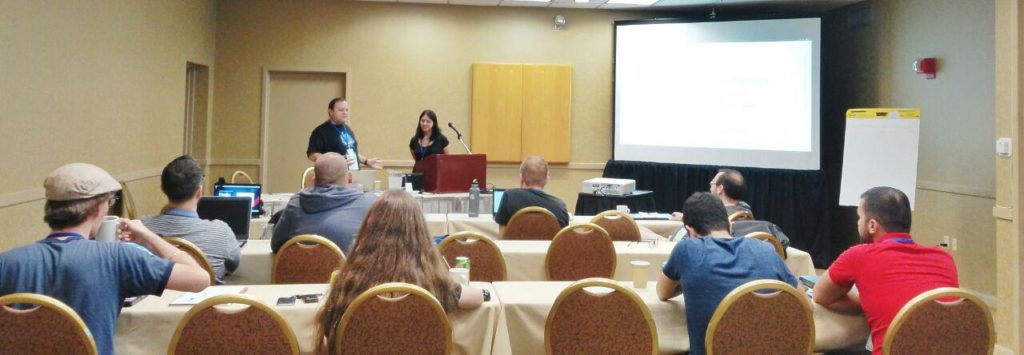 Opening speech during the first day (Creative Commons – Attribution-ShareAlike 4.0 International)
Opening speech during the first day (Creative Commons – Attribution-ShareAlike 4.0 International)
As one of the newest members of the Fedora Community, Flock to Fedora 2017 was a great opportunity for me to get to know the Project and other community members from different regions better. This year’s Flock was held in Cape Cod in Massachusetts, USA. I had the chance to attend the conference as an Ambassador, since I got accepted only one week before the event. To me, those four days were a great chance to hang out with fellow attendees with diverse backgrounds, who share the same passion for the Fedora Project and exchange ideas on how to work and collaborate with each other. The entire community gave me a warm welcome!
The Diversity session
 The Diversity team (Creative Commons – Attribution-ShareAlike 4.0 International)
The Diversity team (Creative Commons – Attribution-ShareAlike 4.0 International)
Initially, I got involved in the project at the Diversity Team. I could not miss the workshop held by Justin Flory, Amita Sharma and Jona Azizaj. This session was really clear for all these people who would like to help underrepresented groups get involved in a tech community, such as the Fedora Project. Also, we had the chance to build a 6-month strategy for the events that the Diversity Team is planning to organize.
At first, the session owners presented a few events that were organized and/or are planned to be organized in the next months, such as the LGBT event in May, Fedora Women Day in September and a Disabilities’ event in December. During the session was emphasized the importance of having different kinds of audiences during these events and combining forces with other larger groups that share the same principles. It’s important for people to understand that Diversity aims to organize an event “with you” and not only “for you”. First of all, we need to localize all these different underrepresented groups, since there are some many factors that would make that difficult. Some of those factors, for instance, could be physical access to event venues, age or fear of coming out publicly. Also, having a list of local events/conferences among regions would help those who want to organize an event find a proper place to approach these groups of people. This could also help deal with budget issues since it could be divided in a better way.
The speakers announced to their audience how to be part of the Fedora Diversity Team. First of all, they suggested that all those people who would like to be part of the Team introduce themselves on the mailing list. Joining the meetings on IRC and Telegram is the next step. All the decisions that have to do with events and budget issues are made on these meetings. Along with the respective tickets on Pagure.
All agreed that having guidelines is a milestone, but being flexible on the other hand, could make those events more efficient. Having in mind that every event is unique due to its audience, geographical region or agenda, we need estimations before organizing them. Estimates, for instance, on the number of people we expect to be present and the impact on them. Setting questions in advance is a good way to try to predict, as much as possible, some metrics. Also, we need to come up with a guideline for evaluating the success/impact and share it with other parts of the Project.
During the session, we set some goals for the future. One of them was having a Code of Conduct that would help deal with inappropriate/bad behaviors. Geographic diversity aspects were another issue we need to deal with in the near future. We need to have the ambassadors as connecting points, since the different levels of speaking English, for example, make it difficult to follow up on global events. Also, we need to extend users’ diversity, not only contributors’. The Contributors’ Survey was something discussed. We agreed that we have to identify its purpose and come up with an analysis plan. We need to understand better how we are going to work with the data that we’ll collect and how to make that publicly accessible.
At the end of the session, Marina Zhurakhinskaya, one of the co-organizers of Outreachy, introduced this internship to the audience. One more time, Fedora is part of Outreachy. Earlier this week a blog post was published on this at the Community Blog. To me, Outreachy is a great opportunity for everyone who comes from an underrepresented social group to be part of this scholarship and work or mentor someone else who needs their help.
Fedora Ambassadors: The future
 Jona & Nick (Creative Commons – Attribution-ShareAlike 4.0 International)
Jona & Nick (Creative Commons – Attribution-ShareAlike 4.0 International)
As I mentioned at the beginning, I attended Flock this year as a freshman ambassador. One of the sessions that I didn’t want to miss was the workshop by Nick Debout and Jona Azizaj about the future of the Fedora Ambassadors. I really wanted to understand better how the process works in order to organize events more effectively in the future. I have to admit that both Nick and Jona gave a great talk, describing step by step everything an ambassador should do.
Nick and Jona started their session by presenting to the audience the steps they have to follow in order to organize an event and ask for a budget. They made it clear that you don’t have to be necessarily an ambassador to organize an event and ask for a budget, but in some cases, it is difficult to claim a budget if you’re not. The first step in that is creating a wiki page that should contain information on the date of the event, the venue, the agenda and the impact you expect to have on the attendees. Opening a new ticket on Pagure is the next step. At the ticket should be included the link to the wiki page, a description and of course the amount of money that is being requested. At the Pagure ticket, it should also include the swag request, if any.
Request tickets get discussed during the regional ambassadors meetings and decided whether they should get accepted or not. Another important element is the event report after the event. It is really important to understand at the end of an event if the set goals in the beginning were accomplished. These kinds of events usually contain information on the number of attendees, the activities that took place and attendees’ thoughts on the event. These reports help in creating better and more efficient events in the future. They can also help prevent past mistakes. These reports usually get posted on wiki pages or personal blogs. Nick’s idea was that if someone doesn’t own a personal blog, they can post their report on the mailing list so everybody can read it!
Another topic that was discussed among the session owners and the audience was the process people should follow to become a Fedora Ambassador. As someone who had recently been through this, it was a surprise for me to find out that there is no certain “protocol” that should be followed. Mostly, it depends on the mentor chosen by the candidate and their perspective on “evaluating” if he/she is ready to be an Ambassador.
Matthew Miller’s blogpost, which was published at the community blog, was another issue that triggered the interest of people who were present in that room. The blog post was about the new Objectives the Council is proposing for the entire project in a time frame of 12 to 18 months. It’s not a secret that the Fedora Ambassadors across regions have diverse backgrounds. The need to identify the proper places to present Fedora by the ambassadors brought up the idea of “dividing” into groups in order to send the proper person to the proper event/conference. That would make it more effective to present the Fedora OS and the Fedora Community to various audiences. Thus, that was just an idea since it is really difficult to divide and evaluate people by their skills and experience.
As a conclusion, I have to say that this Flock, my very first Flock, was a great experience for me. I am happy that I met contributors from different parts of the Project and discussed our views on the Fedora Project. Coming back home now, I feel more motivated from the stories I heard and the talks and workshops I was able to attend. Looking forward to many more Flocks!